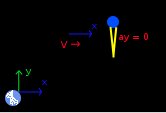Next: Example 6, Previous: Example 4, Up: Examples kinematics of particles [Contents][Index]
3.5 Example 5
A swimmer want to cross a river with a width of 25 meters. Its current have a velocity of 7 m/s. The swimmer take a perpendicular direction to the rive. If the swimmer have a velocity of 7 m/s, how minutes needs to cross the river?, what distance was dragged the swimmer?
Solution with FisicaLab
The velocity of the swimmer is in reference to the river, that is a mobile reference system in reference to the share. With this in mind, erase the content of the chalkboard. And add one element Mobile reference system in X, one element Mobile in Y with constant velocity, and one element Stationary reference system. As show the image below:

We assume that the river’s movement is in the direction of the positive X axis. That the swimmer take the direction of the positive Y axis. And that both, the reference system and the swimmer, start from the origin of the stationary reference system. The end time is an unknown data:
- tf
t
To the Mobile in Y with constant velocity, we call this Swimmer, write:
- Name
Swimmer
- yi
0
- yf
25
- ti
0
- vy
2
To the Mobile reference system in X, write:
- Name
Mobile system
- Object
Swimmer
- xsi
0
- vsx
7
- xof
xf
- vxof
vf
We write the final velocity to the swimmer in reference to the stationary system, vxof, as an unknown data, to satisfied numbers of equations = numbers of unknown data. Of course, this velocity is 7 m/s, because the swimmer don’t have a velocity in X axis. Now click in the icon Solve to get the answer.
t = 12.500 s ; xf = 87.500 m ; vf = 7.000 m/s ; Status = success.